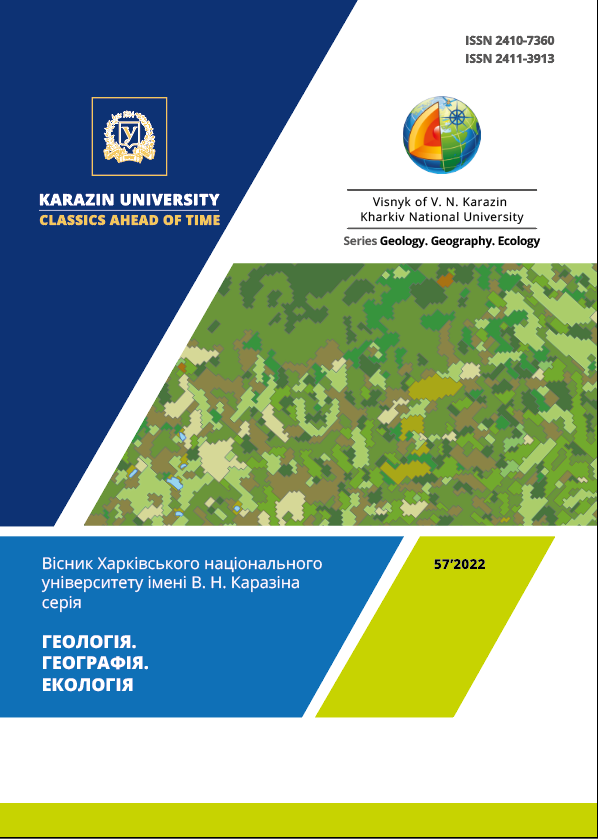Польські етнокультурні ландшафти Поділля: структура, використання, охорона культурної спадщини
Анотація
У статті проаналізовано особливості структури польських етнокультурних ландшафтів сіл та містечок Поділля. У дослідженні розглянуто загальні закономірності формування маєткових, фортифікаційних та промислових ландшафтів, їх етнокультурні риси та особливості господарювання польського етносу. Підхід фахової оцінки ресурсного потенціалу етнокультурних ландшафтів засновано на обґрунтуванні його ефективного використання, зокрема, при проектуванні регіональної мережі етнокультурних заповідних територій, що відповідає концепції сталого розвитку України. Сформовані пропозиції щодо оптимізації та інтенсифікації природокористування польських етнокультурних ландшафтів шляхом охорони та музеєфікації (регіональні ландшафтні парки, скансени) польських історико-культурних артефактів регіону. Польські етнокультурні ландшафти Поділля проаналізовані як об’єкт етнокультурного туризму. Відповідно, вони зберігатимуть біорізноманітність, створюючи підґрунтя для гармонійного поєднання природоохоронної і освітньої діяльності з можливістю ознайомлення з польською історико-культурною спадщиною регіону. Враховуючи кількість та просторовий розподіл об’єктів польської етнокультурної спадщини Поділля, запропоновано створення ландшафтного кадастру як одного з головних пріоритетів у сфері їх охорони та моніторингу антропогенних ландшафтів. Уніфікація польських етнокультурних артефактів у селах та містечках регіону сприяє перетворенню спадщини на туристичний продукт, що зумовлює інтерес до збереження пам’яток та збільшує кількість відвідувачів. Дослідження сприяє оцінці ступеня впливу польської етнокультурної спадщини на розвиток туризму у Східній Європі. Це дозволить розробити практичні рекомендації щодо збереження та використання етнокультурної спадщини в сучасних соціально-економічних умовах, реалізації цільових програм із залученням фінансів ЄС, коли можливий прибуток може значно перевищити вкладені кошти. Досліджувана етнокультурна спадщина є одним із пріоритетів міжнародного туризму провідних країн світу.
Завантаження
Посилання
Volovyk V.M. (2013). Ethnocultural landscapes: regional structures and nature management. Vinnytsia, Vinnytsia City Printing House LLC, 464 [in Ukrainian].
Volovyk V.M. (2011). History of the study of Polish ethnoculture in the small towns of Podillya. History of Ukraini-an geography: All-Ukrainian scientific-theoretical journal, issue 23, 32-36 [in Ukrainian].
Volovyk V.M. (2015). Polish rural ethnocultural landscapes of Podillya. Bulletin of Kharkiv National University named after V.N. Karazina, 1147, series "Ecology", issue 12, 41-47 [in Ukrainian].
Volovyk V.M. (2011). Formation of Polish cultural landscapes of Podillya towns. Geography and tourism: a scien-tific collection. Issue 15, 242-248 [in Ukrainian].
Volovyk V.M., Balinsky I.A. (2018). Ethnocultural landscapes of Bratslav. Scientific journal "Young Scientist", 4 56), 404-409. [Electronic resource]. Available at: http://molodyvcheny.in.ua/files/journal/2018/4/93.pdf. [in Ukrainian].
Volovyk V.M., Mykhailenko T.Yu. (2016). Polish ethnocultural landscapes of the small town of Brailiv. Scientific notes of Vinnytsia State Pedagogical University named after Mykhailo Kotsyubynsky. Series: Geography, Issue 28, 1-2, 26-31 [in Ukrainian].
Volovyk V.M., Pavlichko B.V. (2017). Ethnocultural landscapes of the small town of Brailov. Scientific notes of Vin-nytsia State Pedagogical University named after Mykhailo Kotsyubynsky. Series: Geography, Issue 29, 3-4, 38-44 [in Ukrainian].
Volovyk V.M., Slivinska A.S. (2019). Ethnocultural frame landscapes of the town of Khmilnyk, Vinnytsia region. Scientific journal "Young Scientist", 5 (69), 287-291 [Electronic resource]. Available at: http://molodyvcheny.in.ua/files/journal/2019/5/63.pdf. [in Ukrainian].
Gordunovsky O.M. (2000). Development of industrial production in the landed estates of the Right Bank of Ukraine in the first half of the XIX century. Ukrainian Historical Journal, 2000, 1, 61-71 [in Ukrainian].
Hrushevsky M.S. (1991). History of Ukraine-Russia: in 11 volumes, 12 books. K., Nauk. dumka, Vol. 5, 704 [in Ukrainian].
Denysyk G.I., Braslavska O.V., Volovyk V.M., Valchuk-Orkusha O.M., Buryak-Gabrys I.O., Stefankov L.L. (2021). Frame anthropogenic landscapes: monograph. Vinnytsia, TWORY, 316. (Series "Anthropogenic landscapes of Po-dillya") [in Ukrainian].
Denysyk G.I., Fadeeva T.Yu., Volovyk V.M. (2019). Anthropogenization of Podillya landscapes: monograph. Vinny-tsia, Twory, 288 (Series "Anthropogenic landscapes of Podillya") [in Ukrainian].
Economic history of Ukraine: Historical and economic research: in 2 volumes (2011). K., Nika-Center, Vol. 1, 696 [in Ukrainian].
Zadorozhny V.E. (1989). Commodity production and trade in western Ukraine. Lviv, Vyshcha shkola, 152 [in Ukrainian].
Zadorozhnyuk A.B. (2006). The fate of urban production in the economic life of the Podolsk province in the late XVIII - early XX centuries. Scientific works of Kamyanets-Podilsky State Pedagogical University: historical sci-ences. Kamenets-Podolsky: Oium. Vol. 16: In honor of Professor A.O. Kopilov, 205-219 [in Ukrainian].
Brief reports of the All-Ukrainian Archaeological Committee (hereinafter - KZ VUAK) for 1926 (1926). 193-207 [in Ukrainian].
Kushnir L.B. (1999). The Polish population in the Khmelnytsky region: pages of history. Poles in the Khmelnytsky region: A look through the ages: coll. science. etc. on the materials of intl. science. conference (June 23-24, 1999), 64-71 [in Ukrainian].
Pazhimsky O.M. (1997). Manor ensembles of Podilska Volyn. Samchyky-Khmelnytsky, 216 [in Ukrainian].
Podillya: Historical and Ethnographic Research (1994). K., Dolya, 504 [in Ukrainian].
Simashkevich M. (1875). Historical, geographical and ethnographic sketch of Podolia. Podolian Diocesan Gazette, 4, 126, 137; 6, 189-190; 8, 250 [in Russian].
Adamczyk J. L. (2004) Fortyfikacje stałe na polskim przedmurzu od połowy XV do końca XVIII wieku. Kielce, Politechnika Świętokryska, 249.
Denysyk G., Volovyk V., Buriak-Habrys I., Kikavets V., Skowron K. (2020). Miasteczka Wschodniego Podola: różnorodność i specyfikacja struktur krajobrazowych, klasyfikacja. Periodyk Naukowy Akademii Polonijnej, Częstochowa, 40 (2020), 3, 192-204. https://doi.org/10.23856/4025.
Myga-Piątek Urszula. (2012). Krajobrazy kulturowe: aspekty ewolucyjne i typologiczne. Katowice, Uniwersytet Śląski, 382.
Przewodnik po Polsce w 4 tomah. Tom II. Polska Południowo-Wschodnia. 19 map i 8 planów miast (1937). Warszawa, 540.





